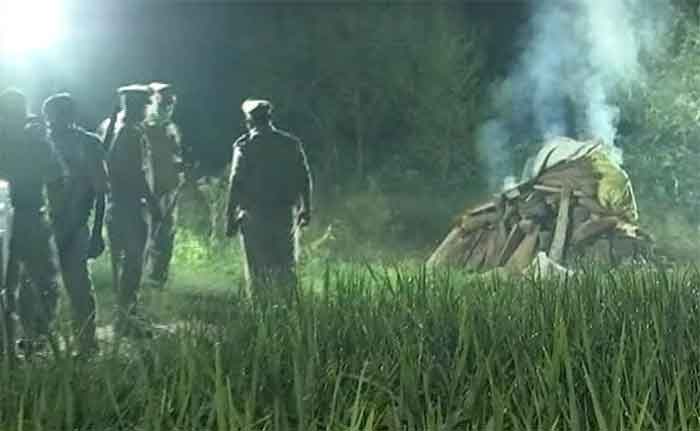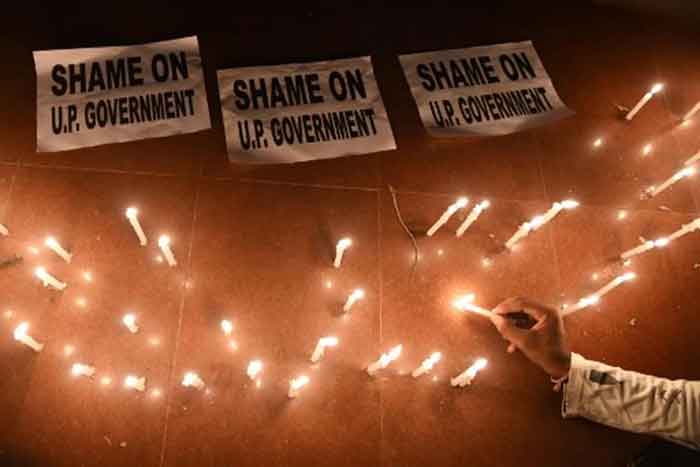
It is not surprising when Police, judicial system and mainstream media deny the existence of caste in Hathras rape case. This practice of denial is a historical, ritualistic and expected strategy from the dominant caste ideologies to decontextualise, depoliticise deradicalise responses to Dalit atrocities from their content and context. In such incidents of atrocity, every time, Dalits have to prove that caste is and has been an inevitable and primary cause of violence on their body. From filing an FIR to getting heard in the court, Dalits have to prove their structural humiliation and violence on them in every step.
The rhetoric of denial from Police, Judiciary System and mainstream media:
The historical evidence shows that the judiciary system, police, media are always reluctant to accept the presence of caste angle in Dalit atrocity cases. Here are few facts where they refused to accept the presence of caste:
- In Khairlanji episode in 2006, the caste basis for the violence against the Bhotmange family was trashed by the Nagpur Bench of the high court on July 2010, and relevant sections of the Prevention of Atrocities against Scheduled Castes Act (POA) were therefore not applied. Exactly after a decade, in 2016, only 8 of the 54 accused were found to be guilty and sentenced to life. Most of the accused thus were acquitted, including the main culprit, a known BJP leader. Others served sentences for lighter charges, and the charge of rape was dropped. The Bombay High Court further acquitted a few of the accused and commuted the death sentence into life imprisonment. The matter is pending in the Supreme Court. The lone survivor Bhaiyalal Bhotmange died a few years back, waiting for justice.
- Dominant caste perpetrators of gang rape of a 15-year-old Kiran Rani from Kanpur district, Uttar Pradesh, in 2001, after the girl’s family approached the police to file a complaint, said to Kiran Rani family, “The police station is an extension of our home. The police are our brothers-in-law. Do you think you can harm us by going to the police?” When the Dalit girl’s family approached the police, the Station Officer said, “However much I try to help you people, the Thakurs of Tilakpur have made all this [gang rape] their business and habit. They will not be stopped.” (NCDHR Report:2020)
- A Dalit woman in a Patna village was stripped and paraded in the streets by dominant caste men to avenge an affront to their pride. When she went to register a case at the police station, the police discouraged her straightaway. The police say, “Do not file a case. You are so poor, you will die. Do you even have food to eat?” It was when the media and the Sarpanch got involved that the police registered an FIR.(1)
- In India, out of all the instances of violence, only in 1.6% are the Dalit women able to obtain informal justice rulings in her favour.(Aloysius Irudayam S. J., Jayshree P. Mangubhai, Joel G. Lee: 2012)
- Despite the Scheduled Castes and Tribes (Prevention of Atrocities) Act, 1989 being the premier legislation to protect the security of life for SCs/STs, from 2009 to 2013 only one-third of total crimes against SCs across India were registered under SCs, and STs (PoA) Act 1989 provisions and the rest were registered under other legislations. (NCDHR Report:2020)
Like the police and judiciary system, the mainstream media too seem to be not comfortable to accept the existence of caste in Dalit atrocity case. For an instant, in Rohit Vemula case, the whole debate in mainstream media revolved around whether Rohit Vemula was a Dalit or not. The mainstream media rhetoric use of word “sexual violence” instead of “caste-based sexual violence”, “Violence on women’s body” instead of “Violence on Dalit women’s Body” in Dalit atrocity cases make their position on Caste ambiguous and susceptible.
How do we establish presence of Caste?
There are two ways of investigating the presence of caste in a case like Hathras. One is by analyzing the victim’s testimony, and the second is by analyzing the responses of official state machinery representatives, mainstream media. Victim’s testimony clearly show how atrocity function as a mode of teaching a lesson to the entire Dalit community. It also uncovers upper caste’s historical practice of untouchability and violence in everyday life. Victim’s brother and cousins narrated how even now when they go to a shop in the area, the shop-keeper sprinkles water on the money they hand over. The Wire and Newslaundry reports of Hathras incident collected many such experiences to underline how caste discrimination and violence is a regular feature, an everyday reality in the Victim’s Boolgarhi village of Hathras.
Mainstream Media Response in Hathras case:
Further, the responses of major media channels to the Hathras case is along the expected line of denying the existence of caste angle to the criminal act of alleged rape and murder. Mainstream Television news reported that “it is only when the political parties politicise a women’s issue for their interests, the caste comes into the picture in such cases of rape”. So it means that caste is not simply out-there in a situation but something which is constructed afterwards by political parties for their interest. In other words, according to some media channels caste is invented after an incident takes place and hence used instrumentally.
If we assume this narrative as an authentic truth, the visualization will be something like this: When village upper caste men see a woman, they see the body of woman without sensing her caste affiliation. Do they not evaluate questions like, who the girl is? Is she endowed with social-structural advantage to rebel in extreme cases of causing harm to her modesty? What could be the consequence of inflicting extreme violence on her body within the society? If the investigative agencies, media and the Judiciary try and ask these questions in establishing the truth, then probably caste of the victim becomes the critical input that was absent in all such cases.
Response of the Police and the District Administration
Police response to the victim has been the most insensitive and clearly shows a bias towards the perpetrators of violence rather than towards the victim. When the family of the alleged rape victim requested the Police to file an FIR, they declined as in the case of some of the cases mentioned earlier. They took a photo and laughed off as if nothing happened. The brother of the victim complained: “The police kept telling us to, Just take her from here.[Police station] She’s[victim] being dramatic and lying here. Do you want to trap us?” (2)The police prevented the family from even seeing the victim one last time, held back all the villagers, and most insensitively burnt her body in the dead of night. In an open letter written on October 3, 2020, over 90 former civil servants from across the country have demanded for an SC/ST Prevention of Atrocities case to be filed against Hathras police and the District Magistrate, whose alleged negligence have impacted the further investigation of the case. (3) The video purportedly shows how Hathras DM Praveen Kumar Laxar force Victim’s family to change their statement. (4)
UP Police’s insensitivity towards the victim and her family is echoed loudly in their utterances. The district Superintendent of Police in an interview said, “On ground, there’s no particular caste-based tension. We have invoked SC and ST Act because the attackers are from one caste and the victim is from another”. Several questions can be asked of this statement: Is it right to treat attacker’s and victim’s caste backgrounds as a mere coincidence? If yes, then is there any exceptional example of such coincidence in an Indian village where upper caste men gang raped and murdered upper caste women in such brutal way, where they treat the upper caste women’s body as trash? If not, why have there been similar patterns across all villages where such instances have taken place in which the attackers were always from the upper caste community and the victims were always from the Dalit community? When there are hundreds of such examples of violence against the Dalit women bodies by the upper caste men, how could it be treated as a mere coincidence?
Conclusion:
The collective conscience, public legitimacy and sensibility of Indian people are exclusively limited up to “justice for women”, without asking who this woman was? For many, Hathras is an event which can be solved by hanging the rapist. However, for Dalit, it is just one part of the everyday life story, which got public sympathy.
Caste gives us the most radical context to raise uncomfortable questions: What about everyday caste violence and unconstitutional practice of untouchability in Bulgarhi village? What about the security of the victim family in specific and Valmiki community in general in the village and how does one respond to the Savarna Parishad support the rapists. In many villages, near Bulgarhi, the Thakur-Brahmin castes comes together and articulate and preserve the Savarna interest.
Fear is an inevitable part of Dalit life, especially among those Dalits who are a minority in the multi-caste villages. In everyday life in the village, Dalits have to negotiate between fear and dignity. If Dalits decide to take a stand, they have to face the consequences. That is why the Thakur family had attacked victim’s grandfather and cut his finger with a sickle when he decided to raise his voice. (5) Dalit have to live with these existential questions, fear, pain and humiliation. Metaphorically, Dalits of Bhulgarhi and other villages of Uttar Pradesh have two choices: Stay inside the home and never voice out or step out from home and resist. While the former continues topervade many villages of Indian society, the latter course is also visible and that is the silver lining in the current context of Hathras.
Reference:
1.https://www.newsclick.in/Khairlanji-Hathras-Rape-Story-Repeats-Dalit-Women
4.https://www.thehindu.com/news/national/other-states/their-revenge-on-her body/article5160780.ece-
6.https://thewire.in/caste/hathras-gangrape-sc-st-atrocities-act-demand
- NCDHR Report(2020): Status report on the implementation of POA 1989 and Rules 1995
- Aloysius Irudayam S. J., Jayshree P. Mangubhai, Joel G. Lee(2012): Dalit Women Speak Out: Caste, Class and Gender Violence in India: Caste, Class and Gender Violence in India: Zubaan an Asso. of Kali for Women Publication.
Akash Sulochana ([email protected]) is an MPhil Research Scholar with the Zakir Husain Centre for Educational Studies, Jawaharlal Nehru University, Delhi.
SIGN UP FOR COUNTERCURRENTS DAILY NEWSLETTER















































